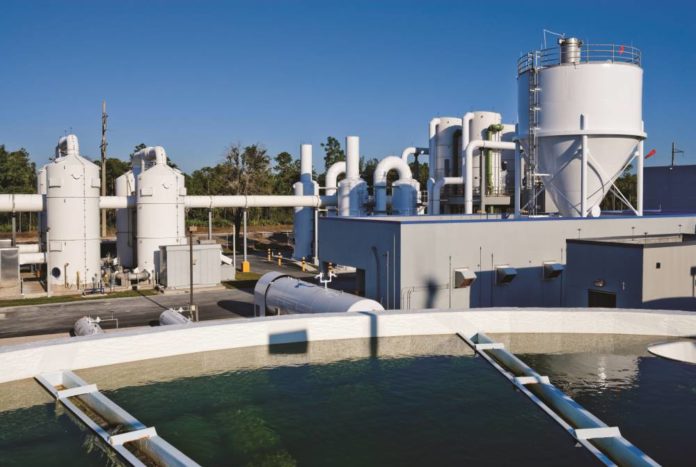By Keith Hayward
Use of desalination to produce fresh water has escalated dramatically over recent years. The aim of the global assessment by the team led by the United Nations University Institute for Water, Environment and Health (see News, page 10) was to provide a full picture of that contribution. This is particularly in terms of bringing academic literature up to date, which is a foundation for a wider input to policy.
The study is part of a broader project to look at the opportunities for unconventional water resources.
“We know that water scarcity is increasing in many regions across the world,” says Dr Manzoor Qadir, assistant director at the Canadian institute. “We really need to look beyond conventional water resources.”
In some respects, the desalination study puts into the scientific literature what is known already as far as water production is concerned. It analysed already-existing data on desalination plants. Nonetheless, it contributes a clearer picture of the 16,000 desalination plants around the world, with a combined output of 95Mm3/day of water.
The study’s big contribution is the picture it provides of the scale of brine produced – that flow of water containing the salt removed in the production of clean water. Using the data, the study represents the first comprehensive quantification of the volume of brine. The global figure, of around 142Mm3/day, is far greater than previously estimated, it finds.
Brine is increasingly of concern because of the impact on the environment of its high salinity and of chemicals used during desalination.
Qadir sees that the study, reported in the journal Science of the Total Environment, has an awareness-raising dimension for public policy on this issue.
“Those in the decision-making process may start thinking that now, while we are benefitting from desalinated water, we should also start paying attention to an environmentally-sustainable way of brine disposal,” says Qadir.
The study found that the Middle East and North Africa region accounts for almost 100Mm3/day of brine production – 70% of the global figure, and around double the volume of desalinated water produced there. Saudi Arabia and UAE produce around 22% and 20% of the global total respectively.
The study added to the picture of inland desalination, where brine cannot readily be disposed of to sea. It found that almost 22Mm3/day of brine is produced more than 50km from the nearest coastline. China is responsible for the largest share (3.82Mm3/day), but the research showed that 64 countries produce more than 10,000m3/day of brine in inland locations.
The amount of brine created at any particular location depends on the salinity of the feed water and the technology used. Another contribution from the study is the assessment method that has been developed. This combined feed water salinity, technology type and plant capacity for each plant, and estimated the amount of brine based on an extensive review of recovery ratios – the proportion of purified water for each feed water-technology combination.
“We developed a methodology to determine brine production, so that could be used further or maybe further refined as well,” says Qadir.
When unconventional becomes conventional
What the study also highlights is that, for some countries, desalination is a mainstream source of water, even if desalination is unconventional in a global sense.
Eight countries produce more desalinated water than the freshwater volume they withdraw for human use: the Maldives, Singapore, Qatar, Malta, Antigua and Barbuda, Kuwait, the Bahamas, and Bahrain.
Furthermore, another six countries meet more than half of their water withdrawals through desalination: Equatorial Guinea, UAE, Seychelles, Cape Verde, Oman, and Barbados.
Desalination is therefore already an essential source of water in the Middle East and for some small island nations.
Because of this, the researchers argue in their paper that the current indicator of water stress, set out in Sustainable Development Goal indicator 6.4.2 as freshwater withdrawal as a proportion of available freshwater resources, fails to reflect the actual extent to which countries may or may not be experiencing stress because of their ability to exploit unconventional resources.
Future needs
Qadir highlights two broad areas for further work on desalination. “We need to increase the efficiency of the desalination process, so we produce more desalinated water and less brine,” he says. “A second would be to treat or use the brine that is produced in an economically viable and environmentally friendly way.”
This latter area includes opportunities such as using the brine in aquaculture or recovering metals and salt. “These type of options still remain on a very pilot scale. They need to go beyond pilot scale into more large scale commercially or economically viable options,” says Qadir.
Such opportunities for desalination fit within the wider outlook of the unconventional water resources project the institute is leading.
“This project is basically a response to global, regional and local water scarcities. We are looking at all potential unconventional water resources, such as desalinated water, treated wastewater, even water from air, like fog water collection or cloud seeding,” says Qadir, also adding rainwater harvesting to the list.
The project is currently set to run to the end of this year, and Qadir also points out that the institute coordinates the UN Water Task Force on unconventional water resources, which was established in 2017.
One area for early attention is use of desalinated water in agriculture. Desalination is generally seen as an expensive source of water, with agriculture the use where this cost is most likely to be a barrier. The study found that irrigation accounts for 1.8% of desalinated water production.
“We would like to see where it is being used, what its potential is, what are its limitations,” says Qadir. Other aspects include looking more closely at the scale of use and where it is expected to be used. “That would be the next study that we are planning to undertake,” he concludes.








